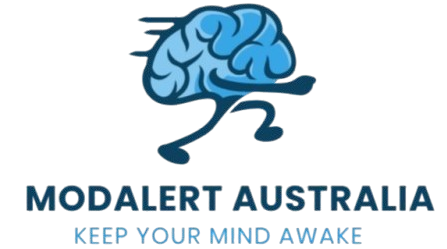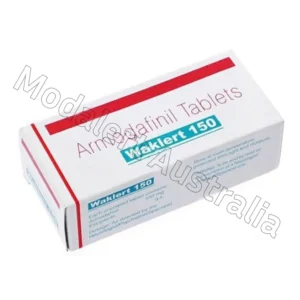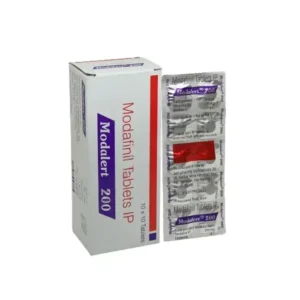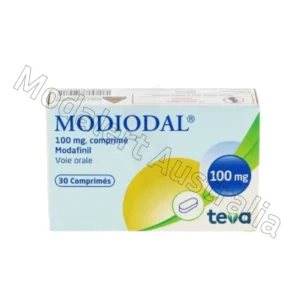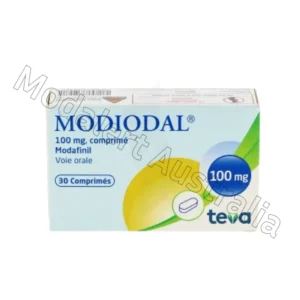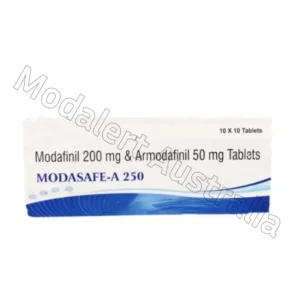Is Modafinil a Strong Stimulant?

Introduction
Modafinil is a widely known cognitive enhancer and wakefulness-promoting agent. It is often referred to as a “Smart Drug“ and is also known as a “Nootropic.” It is recommended for Narcolepsy, sleep shift disorder (SWSD), OSA, and obstructive sleep apnea (OSA). However, its use off-label for professionals, students, and biohackers has led to debates regarding whether Modafinil constitutes an effective stimulant similar to conventional stimulants such as amphetamines or methylphenidate.
Modafinil is a medicine that keeps patients alert. Doctors prescribe it to treat insomnia disorders such as Narcolepsy. However, many individuals take it without prescription as it aids in concentration. It’s a debate whether it’s a “strong” stimulant such as Adderall or a light awakeness drug.
It can be described as a robust coffee with no anxiety. Other people compare it to mild amphetamines. It’s somewhere between the two. However, defining it as a stimulant or a non-stimulant is not so simple.
At the end of this, you’ll have a good idea of whether Modafinil is classified as a powerful stimulant and if it’s suitable for you.
What Is Modafinil?
Modafinil (sold under various brand names such as Provigil, Modalert, and Alertec) was first developed in the late 1970s, and it was approved in the 1970s by the FDA by the FDA in 1998. In contrast to traditional stimulants, it was created to help people wake up without the feeling of euphoria or jitteriness that comes with amphetamines.
Mechanism of Action
Modafinil’s mechanism of operation isn’t entirely yet understood, but research suggests that it functions through:
• The increase in dopamine levels (by stopping dopamine Reuptake)
• The enhancement of norepinephrine, histamine, and orexin activities
• Enhancing glutamate release and reducing GABA activity
In contrast to amphetamines, which trigger an enormous dopamine boost, Modafinil has a more gentle effect that leads to an extended period of wakefulness that is not accompanied by a significant feeling of EU or the possibility of crashing.
Is Modafinil a Strong Stimulant?
To establish if Modafinil can be described as a “strong” stimulant, we must evaluate it with traditional stimulants such as Adderall (amphetamine) as well as Ritalin (methylphenidate).
Key Differences Between Modafinil and Traditional Stimulants
| Feature | Modafinil | Amphetamines (Adderall) | Methylphenidate (Ritalin) |
| Primary Use | Wakefulness promotion | ADHD, narcolepsy | ADHD, narcolepsy |
| Dopamine Effect | Moderate reuptake inhibition | Strong dopamine release | Strong reuptake inhibition |
| Euphoria | Minimal | High | Moderate |
| Addiction Potential | Low | High | Moderate-high |
| Half-Life | 12-15 hours | 9-14 hours | 2-3 hours |
| Crash | Rare | Common | Common |
Why Modafinil Isn’t a “Strong” Stimulant in the Traditional Sense
- Lacks intense euphoria – Contrary to amphetamines. Modafinil doesn’t create an intense “high”.
- Lower addiction risk – The DEA classified it as a Schedule IV drug (low abuse possibility), While Adderall falls under Schedule II.
- Smoother energy – People report feeling alert and alert without jitteriness from coffee or Adderall.
Modafinil, however, is potent in its wakefulness effects but not as powerful as other stimulants.
How Modafinil Works in the Brain (It’s Not Like Other Stimulants)
Many stimulants, including Adderall as well as caffeine, fill the brain with dopamine. It gives you a surge of energy as well as a euphoria. Modafinil is a different kind of drug.
- The effect is minimal when compared with amphetamines.
- It primarily works on histamine and orexin, two chemicals that regulate sleepiness.
- The brain doesn’t go into hyperdrive. It just keeps the feeling of fatigue.
It isn’t the typical stimulant. No intense highs, no crushing crashes. You’ll feel a steady, alert state.
Does Modafinil Feel Like a Strong Stimulant? User Experiences
Modafinil users explain it using different terms:
- Some say it’s weak – Like a long-lasting coffee, no real “kick”.
- Others say it’s strong – You can sleep up to 12 hours thanks to laser-focused technology.
- A few feel nothing – The bodies of their victims don’t respond much to this.
The distinction is due to the chemistry of your brain. If you’re typically low on energy, Modafinil may feel overwhelming. If you’re already awake, the drug could do virtually nothing.
Physical vs. Mental Effects
- Nobody buzz – Contrary to Adderall and other drugs, you will not be physically pumped up.
- No teeth grinding – An often-reported side effect associated with powerful stimulants. However, it is rare when using Modafinil.
- No crash – It gradually fades away instead of crashing you abruptly.
Cognitive and Performance Effects of Modafinil
Modafinil is a sought-after drug by its effects on cognition, specifically in:
Memory and Learning
- The results of studies show improvements in working memory and memory for episodic events in sleep-deprived people.
- Can improve problem-solving and complicated decisions.
Focus and Motivation
- Enhances the persistence of tasks, which makes the task more manageable.
- Contrary to Adderall, which is a stimulant, Adderall doesn’t cause hyperfocus, but it does hinder imagination.
Mood and Fatigue Resistance
- It reduces fatigue in the brain, making it a favourite among people working shifts and military personnel.
- Certain users have reported moderate mood improvement but no feeling euphoric.
Does It Make You “Smarter”?
- It doesn’t, Intelligence.
- It improves cognitive capabilities by reducing fatigue as well as improving concentration.
Side Effects and Risks
Modafinil can generally be tolerated; however, there are some risks:
Common Side Effects
- Headaches (can be reduced by drinking water)
- Sleepiness (if not taken at the right time of the morning)
- A jittery or anxious feeling (in sensitive people)
- Dry mouth
Rare but Serious Risks
- Reactions to the skin (Stevens-Johnson Syndrome in extreme cases)
- An increase in heart rate or blood pressure
- Dependence (uncommon, but it is possible in the case of misuse)
Who Should Avoid Modafinil?
- People suffering from heart problems
- People suffering from anxiety disorders.
- Pregnant or breastfeeding women
Modafinil vs. Other Stimulants: Which Is Better?
Modafinil vs. Caffeine
- Caffeine gives you a rapid energy boost, but it can increase the risk of crashes.
- Modafinil gives you continuous wakefulness (12 plus hours) without jitters.
Modafinil vs. Adderall
- Adderall has a higher potency in treating ADHD; however, it has a higher risk of abuse.
- Modafinil is best for overall wakefulness and concentration.
Modafinil vs. Armodafinil
- Armodafinil (Nuvigil) Armodafinil (Nuvigil) is an improved version with a longer half-life.
- Certain users prefer it to be easier to use, but the results are similar.
Modafinil vs. Ritalin (Methylphenidate)
- Ritalin helps to focus your attention, but it could cause you to become robotic.
- Modafinil feels more natural and less forced.
Modafinil vs. Nicotine
- Nicotine is a short-lived drug; it increases alertness and then decreases quickly.
- Modafinil is very smooth without any ups or downs.
Legal Status and Ethical Considerations
Prescription Requirements
- Within the U.S., the UK, as well as Australia, Modafinil is a prescription-only drug.
- In certain countries (India, Mexico), it’s more accessible.
Off-Label Use: Is It Ethical?
- Many argue that it’s unfair to discriminate in professional or academic settings.
- Some believe that it’s not different from the caffeine that boosts productivity.
Alternatives for Non-Prescription Users
- Natural stimulants: L-theanine + caffeine, Rhodiola rosea
- Lifestyle changes: meditation, exercise, Sleep optimization
Who Uses Modafinil? (Not Just Narcoleptics)
Medical Uses
- Narcolepsy patients – Keeps them awake and prevents them from falling asleep randomly.
- Shift workers – It helps nurses and truckers remain awake throughout the night.
Off-Label Uses
- Students – Doing all-nighters before taking their tests.
- Programmers – Programming hours of work without burning out.
- Biohackers – Individuals who modify their brain’s chemistry to increase productivity.
Why Some Prefer It over Stronger Stimulants
- Reduce anxiety.
- Absolutely no addiction cravings.
- It doesn’t interfere with sleep in the same way as amphetamines do.
Final Verdict: Is Modafinil a Strong Stimulant?
It’s not a “strong” stimulant in the conventional sense. It does not have the euphoric rush as well as the potential for addiction and adverse effects that are associated with drugs like Adderall and cocaine. However, it is a potent wakefulness drug with positive cognitive effects.
Who Should Try Modafinil?
- Workers in shifts are struggling to sleep
- Students in need of long-term study sessions
- Professionals managing fatigue
Who Should Avoid It?
- Anyone prone to stress
- People suffering from heart problems
- For those who are seeking an enjoyable high
Conclusion
Modafinil is a rare combination of moderate stimulants (like caffeine) and more potent stimulants (like amphetamines). It improves focus and wakefulness with no harsh adverse consequences, making it the most sought-after among biohackers and productivity lovers. But it’s not a miracle cure. Proper nutrition, sleep, and physical activity are essential for peak performance.
If it is used with care, Modafinil is beneficial. However, it’s essential to consider the benefits versus possible risks. Consult a physician before beginning any new supplements or medications.
FAQs About Modafinil
Does Modafinil feel like caffeine?
Similar to the model, but smoother and more durable.
Will Modafinil show up on a drug test?
Most tests at work don’t test for the issue, but specific, specialized tests do.
Can you mix Modafinil with coffee?
Certain do; however, this can cause anxiety as well as heart rate.
Is modafinil illegal?
Most places require a prescription. However, application of the law varies.
Does Modafinil kill creativity?
Many say it causes them to be more focused. Others believe it can help.
